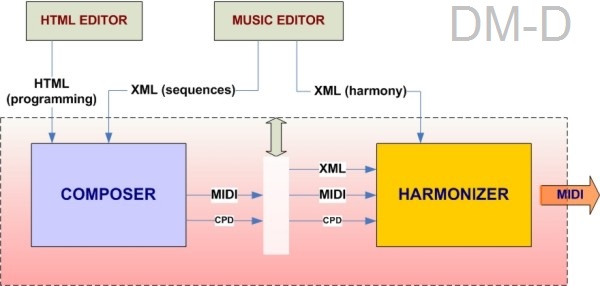As shown in the image, contains 2 modules:
- COMPOSER: Generates the
form and thematic content of the piece.
- HARMONIZER:
Applies
a harmonization to the result of Composer.
In addition, DM-Dog requires for its operation 2 external programs:
- HTML EDITOR: It is
an editor used to write the programming sheet for Composer.
BlockNote
is included
with the installation of DM-D, that is an optimal freeware editor for this
function.
- MUSIC EDITOR:
Composer can
take external musical sequences to develop musical ideas. Harmonizer
also requires that you write the chords to apply color (harmony) to
the piece. Both
actions must be performed with an external editor that supports
exporting to
XML format, like
Finale
or
Sibelius or freeware MuseScore.
|
The communication
between programs and modules is done through files. Therefore,
all information flowing through them can be edited or reviewed at any time. The
basic operation of the program must be done as follows:
1 - Write a
programming sheet for
Composer. Any musical sequence can also be included (in XML format).
2 - Run
Composer.
It generates an intermediate file in Midi or
CPD format, which contains the piece without harmonizing.
3 -Write
the harmony sheet using
the music editor. Then, it must be exported to XML format, so that it
can be recognized by DM-D.
4 - Execute Harmonizer,
that applies the harmony to the file coming from Composer.
The final output is in
MidiFile format.
For further information, see Examples,
Documentation and
Tutorial.
|
